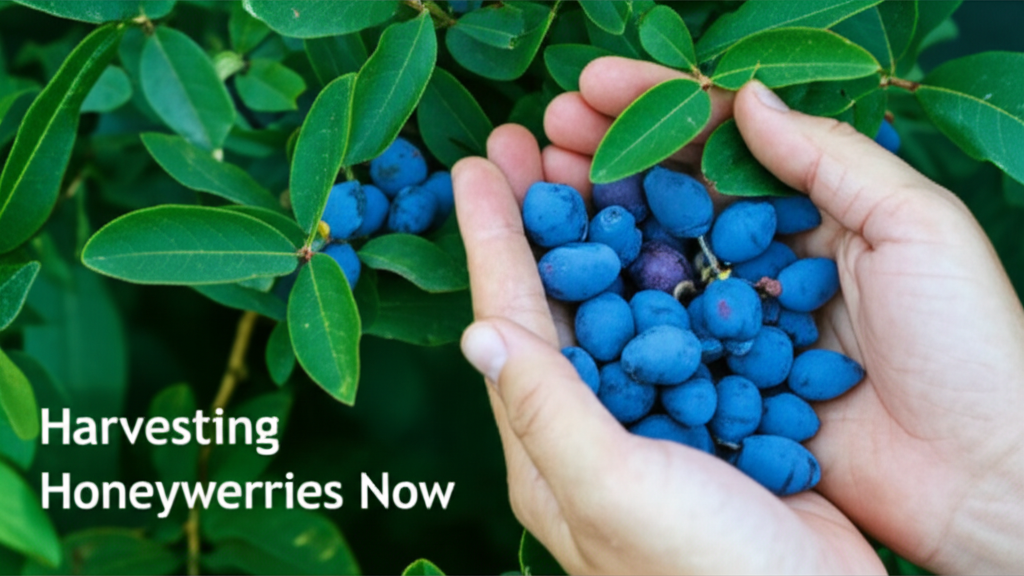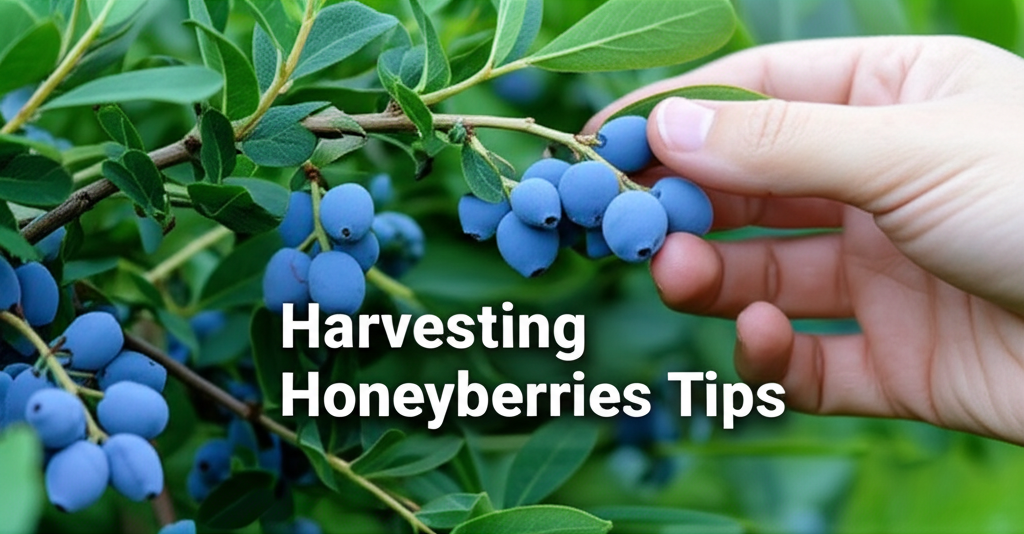Introduction to Honeyberry Harvesting
Honeyberries, also known by their Japanese name Haskap, are an increasingly popular addition to home gardens. These hardy shrubs offer an early-season harvest of delicious, antioxidant-rich berries that are perfect for fresh eating, jams, jellies, and more. For beginner gardeners, understanding the nuances of honeyberry harvesting can significantly enhance the yield and quality of their crop. This guide will walk you through everything you need to know to achieve sweet success with your honeyberry harvest, from knowing when to pick to the best methods for collecting these fascinating fruits.
Understanding Honeyberry Ripening

The key to a successful honeyberry harvest lies in recognizing the signs of ripeness. Unlike some fruits that change dramatically in color, honeyberries can be a bit more subtle. However, paying attention to a few key indicators will ensure you pick your berries at their peak flavor and sweetness.
When to Harvest: The Ripeness Indicators
Several factors signal that your honeyberry shrubs are ready for harvesting:
- Color: While some varieties turn a deep blue or purplish-blue, others may remain a lighter blue or even a reddish-blue when ripe. Don’t solely rely on color; use it in conjunction with other indicators. The best way to gauge ripeness by color is to consult the specific variety you are growing.
- Texture: Ripe honeyberries will yield slightly to gentle pressure. They shouldn’t be rock hard, nor should they be mushy. A gentle squeeze will give you a good indication.
- Taste: This is arguably the most reliable indicator. Sample a few berries from different parts of the shrub. If they are sweet and have lost their tartness, it’s a good sign the majority are ready. Remember, honeyberries are known for their initial tartness that mellows as they ripen.
- Ease of Picking: Ripe honeyberries detach from the stem with a gentle tug. If you have to pull hard, they likely need a few more days.
- Bloom Removal: As honeyberries ripen, the powdery bloom (a waxy coating) on their surface will become more prominent and easily rubs off.
Factors Affecting Ripening Time
Several environmental and horticultural factors can influence when your honeyberries will be ready for picking:
- Variety: Different honeyberry cultivars have distinct ripening windows. Some mature in late spring to early summer, while others can be harvested later.
- Climate: Warmer climates generally lead to earlier ripening. Conversely, cooler regions might see a later harvest.
- Sunlight: Adequate sunlight is crucial for fruit development and sugar production. Shrubs in sunnier locations may ripen faster than those in shaded areas.
- Water and Nutrients: Consistent moisture and proper nutrient availability support healthy fruit development, contributing to timely ripening.
- Pollination: Honeyberries require cross-pollination to produce fruit. Ensuring you have at least two different compatible varieties planted will lead to a much more abundant harvest. The pollination process itself influences fruit set and development.
Key Facts About Honeyberry Harvesting
To effectively harvest your honeyberry crop, understanding these fundamental facts is essential.
| Characteristic | Description |
|---|---|
| Ripening Period | Typically late May through July, depending on variety and climate. |
| Harvest Window | Berries ripen progressively, so multiple pickings may be needed over a few weeks. |
| Fruit Detachment | Ripe berries detach easily with a gentle pull. |
| Storage Life | Fresh honeyberries are best consumed within a few days or can be frozen for longer storage. |
| Flavor Profile | Sweet-tart, often described as a blend of blueberry, raspberry, and blackcurrant. |
Harvesting Techniques for Honeyberries
The way you pick your honeyberries can impact both the current harvest and the health of your plants for future seasons. Here are the best techniques for beginners:
Gentle Picking Method
The most recommended method for harvesting honeyberries is by hand, using a gentle touch.
- Approach the Shrub: Move calmly and deliberately around the plant.
- Locate Ripe Berries: Identify berries that show the signs of ripeness discussed earlier.
- Support the Branch: Gently cup your hand or a small container beneath the cluster of berries you are about to pick. This catches any berries that might fall prematurely.
- Twist or Tug Gently: With your thumb and forefinger, grasp a ripe berry and give it a slight twist or a gentle upward tug. It should detach easily.
- Place in Container: Carefully place the picked berry into your collection container. Avoid dropping them from a height.
- Work Systematically: Move through the shrub, picking only the ripe berries. This allows unripe berries to continue maturing.
Using Harvesting Aids
For larger harvests or when dealing with very productive shrubs, certain tools can be helpful.
- Small Containers: Lightweight baskets or bowls are ideal for collecting berries without crushing them.
- Trays or Flats: For a significant harvest, shallow trays can be useful for spreading out berries and preventing damage.
- Tarps or Sheets (Optional): Some gardeners place a tarp or sheet beneath the shrub to catch any fallen berries. However, use this method with caution, as it can also collect leaves and debris, requiring more sorting.
What to Avoid During Harvesting
To protect your plants and ensure the best quality fruit, avoid these common mistakes:
- Pulling Too Hard: Forcing berries off the stem can damage the plant’s fruiting spurs, reducing future yields.
- Harvesting Too Early: Picking underripe berries will result in a tart, less flavorful product.
- Overfilling Containers: Piling too many berries into one container can lead to crushing and spoilage.
- Harvesting Wet Berries: Picking berries when they are wet (from dew or rain) can promote mold and spoilage during storage. Wait for them to dry.
Steps for a Successful Honeyberry Harvest
Follow these step-by-step instructions to ensure a smooth and bountiful honeyberry harvest.
| Step | Action | Why It’s Important |
|---|---|---|
| 1 | Monitor Ripeness Regularly | Ensures you pick berries at their peak flavor and sweetness. |
| 2 | Gather Your Supplies | Having containers ready makes the harvesting process efficient. |
| 3 | Pick Gently and Selectively | Protects the plant and ensures only ripe berries are collected. |
| 4 | Handle Berries with Care | Prevents bruising, which can lead to spoilage. |
| 5 | Store Properly Immediately | Maintains freshness and quality after picking. |
Pros and Cons of Honeyberry Harvesting
Like any gardening endeavor, honeyberry harvesting has its advantages and potential challenges.
| Pros | Cons |
|---|---|
| Early Season Crop: Often one of the first fruits to ripen in the season. | Delicate Fruit: Berries can be easily bruised if handled roughly. |
| High in Antioxidants: Very healthy fruit, rich in vitamins and anthocyanins. | Requires Cross-Pollination: You need at least two different varieties for a good yield. |
| Easy to Grow: Hardy plants that tolerate various conditions. | Subtle Ripeness Cues: Can be tricky to identify peak ripeness initially. |
| Versatile Uses: Great for fresh consumption, jams, pies, juices, etc. | Progressive Ripening: Requires multiple harvesting trips over several weeks. |
| No Prickles: Unlike some berries, honeyberries are thornless, making harvesting easier. | Susceptible to Birds: Birds often enjoy honeyberries, so netting might be necessary. |
Post-Harvest Care and Storage
Once you’ve finished picking, proper handling and storage are crucial to preserve the quality of your honeyberries.
Storing Fresh Honeyberries
Honeyberries are highly perishable due to their delicate nature.
- Refrigeration: Store picked berries in a single layer if possible, or loosely in shallow containers in the refrigerator. They are best consumed within 3-5 days.
- Avoid Washing Until Use: Do not wash honeyberries until you are ready to eat or process them, as moisture can encourage spoilage.
- Inspect for Damage: Remove any crushed or overripe berries before storing the rest.
Long-Term Storage Options
If you have an abundant harvest, consider these preservation methods:
- Freezing: This is one of the most effective ways to store honeyberries.
- Wash and thoroughly dry the berries.
- Spread them in a single layer on a baking sheet lined with parchment paper.
- Freeze until solid (about 1-2 hours).
- Transfer the frozen berries to airtight freezer bags or containers.
Frozen honeyberries can last for 6-12 months and are excellent for smoothies, baking, and sauces.
- Drying: Honeyberries can be dried in a dehydrator or a low oven. The process can take several hours, and dried berries can be stored in airtight containers for extended periods.
- Jams, Jellies, and Preserves: Cooking honeyberries into jams, jellies, or sauces is a classic preservation method. These can be canned for shelf-stable storage or kept in the refrigerator for several weeks.
Troubleshooting Common Harvesting Issues
Even with the best intentions, you might encounter a few snags. Here’s how to address them:
Birds and Pests
Birds are often the biggest culprits when it comes to honeyberry predation.
- Netting: Installing bird netting over your shrubs as the berries begin to ripen is the most effective deterrent. Ensure the netting is secured at the bottom to prevent birds from getting underneath.
- Scare Devices: While less reliable, visual deterrents like shiny objects or scare tape can sometimes help.
- Companion Planting: Some gardeners experiment with companion planting to deter pests, though specific successful companions for honeyberries are still being researched.
Unripe Berries Remaining on the Shrub
If you notice a significant number of berries that are not ripening, consider these possibilities:
- Insufficient Pollination: Ensure you have at least two different, compatible honeyberry varieties planted.
- Environmental Stress: Lack of water or extreme temperatures can hinder fruit development.
- Age of the Plant: Very young plants may not produce a full crop.
Berry Drop
While ripe berries detach easily, some premature drop can occur.
- Causes: This can be due to stress (heat, drought), disease, or simply the natural shedding of immature fruit.
- Prevention: Maintain consistent watering, provide adequate nutrients, and prune your plants correctly to ensure good air circulation and plant health.
Conclusion
Harvesting honeyberries is a rewarding experience that brings the taste of early summer to your table. By understanding the signs of ripeness, employing gentle harvesting techniques, and properly storing your bounty, you can maximize your yield and enjoy these delicious, healthy berries throughout the year. With a little practice and attention, even beginner gardeners can master the art of the honeyberry harvest, turning their shrubs into a vibrant source of fresh, nutritious fruit. Happy picking!


